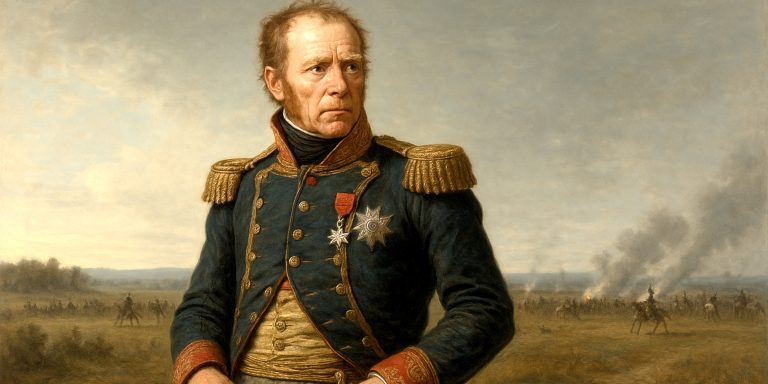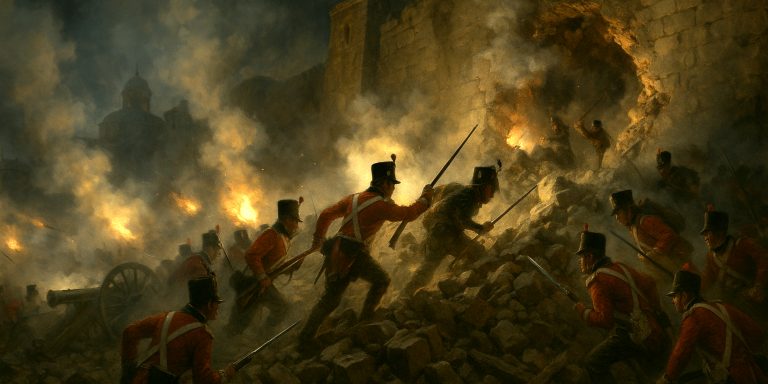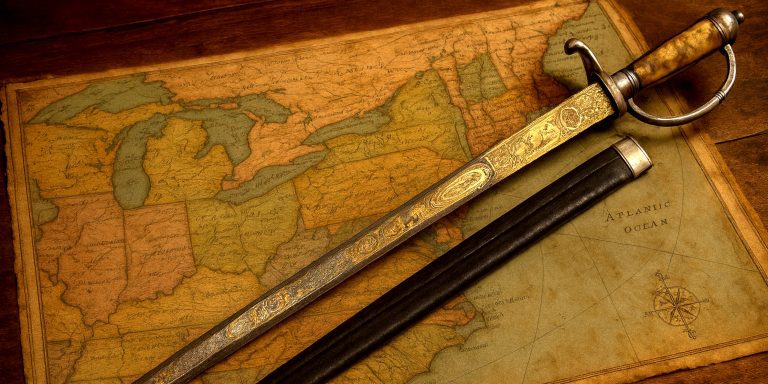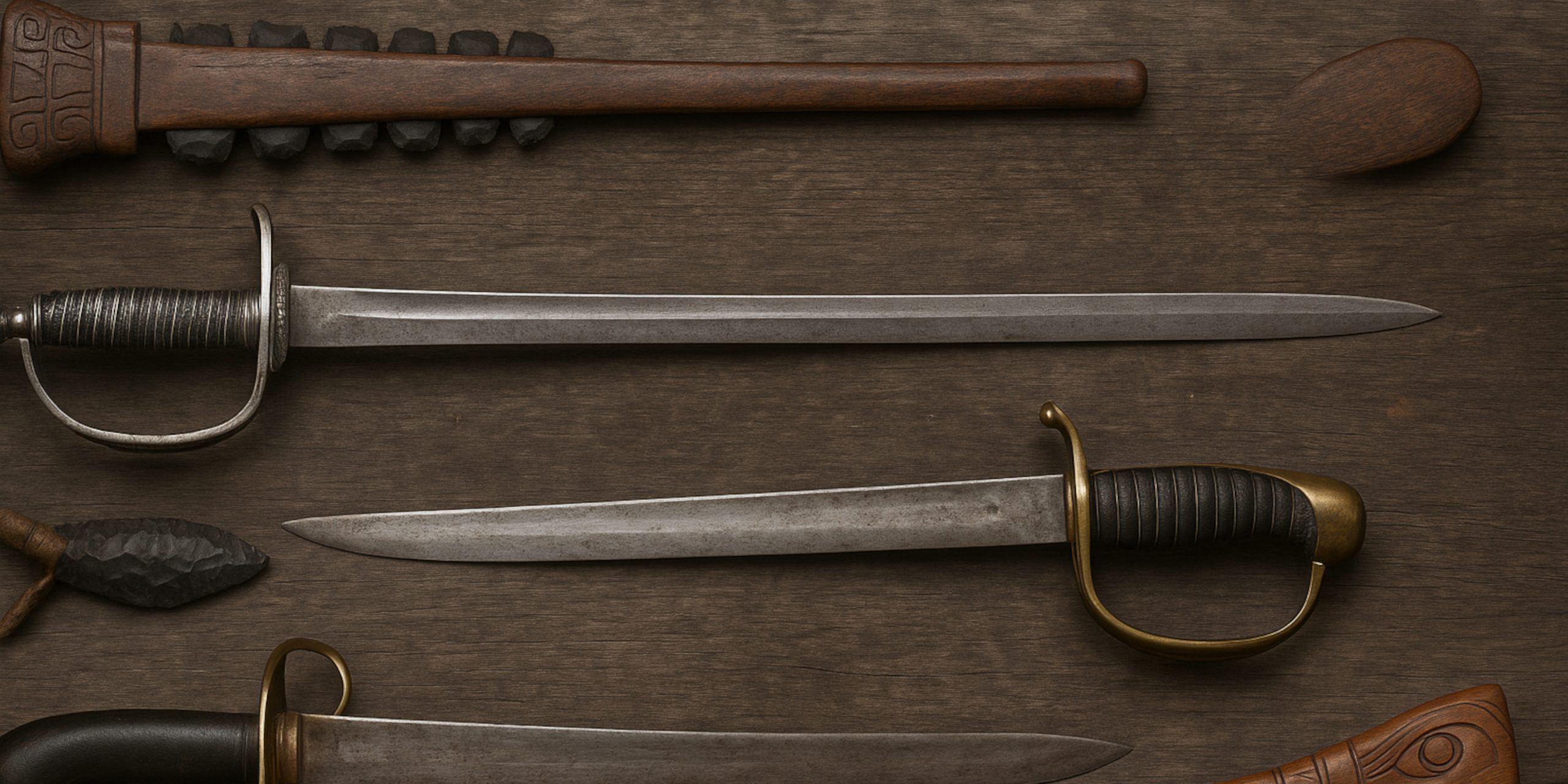
The story of swords in the Americas is not a single continuous tradition. Unlike Europe or Asia, where swordmaking was central to culture and warfare for centuries, the Americas combined Indigenous weapons, imported European blades, and later locally manufactured military swords. Each era reflects the material resources, cultural needs, and military developments of the people who lived and fought there.
Pre-Columbian and Indigenous Swords

Before European contact, Native and Mesoamerican cultures crafted sword-like weapons from stone, copper, and hardwood. The most famous was the macuahuitl of the Aztecs, a heavy wooden club edged with razor-sharp obsidian blades. Spanish accounts record that it could decapitate a horse in a single stroke. Variants included shorter one-handed versions, two-handed great macuahuitls, and ceremonial forms decorated with precious stones.
The Maya and Mixtec used similar obsidian-edged swords, often shorter and lighter, while the Toltecs and Zapotecs had their own regional designs. Farther south, the Taino of the Caribbean wielded the macana, a paddle-shaped hardwood sword that could be edged with shell or flint. In South America, the Inca made hybrid ceremonial sword-knives, and the Chimu and Muisca used bronze or copper-bladed versions.
In North America, the idea of a sword was less common, but many nations developed long bladed or sword-like clubs. The Iroquois and Huron crafted flint-edged clubs, while the Tlingit and Haida of the Pacific Northwest forged copper ceremonial swords. The Inuit fashioned long cutting weapons from whalebone and walrus ivory. With European contact, many tribes adapted imported blades, such as trade cutlasses and smallswords, often decorated with native motifs.
These weapons reveal both the ingenuity of Indigenous craftsmanship and the symbolic role of swords as objects of status. While obsidian and hardwood were brittle compared to steel, they reflected the materials available and were no less deadly in battle.
Pre-Columbian and Indigenous Swords (50 types)
Mesoamerican (Aztec, Maya, Toltec, Mixtec, etc.)
- Macuahuitl (obsidian-edged sword club)
- Short Macuahuitl (one-handed variant)
- Two-handed Macuahuitl (longer form)
- Macuahuitl with cross-hilt design (reported in codices)
- Mayan flint-edged broadsword
- Mixtec ceremonial obsidian sword
- Toltec-style macuahuitl
- Zapotec obsidian-edged staff sword
- Tarascan bronze-edged sword
- Mexica macuahuitl with shark-tooth edges
South and Central American (pre-contact)
- Inca ceremonial tumi-sword hybrid
- Chimu bronze-edged sword
- Muisca wooden sword club
- Carib ironwood war sword
- Arawak paddle-sword
- Taino macana (hardwood sword-club)
- Taino macana with embedded shell blades
- Amazonian hardwood long-sword
- Guarani sword-club with flint blades
- Mapuche rehue sword-club
North American Indigenous
- Iroquois war club sword variant
- Huron flint-edged sword
- Cherokee iron trade sword (modified European)
- Creek long-bladed war knife (sword-length)
- Sioux long bone sword
- Plains Indian sword-lance hybrid
- Apache hardwood sword club
- Pueblo obsidian-edged sword club
- Tlingit copper sword
- Haida ceremonial sword
- Inuit whalebone sword
- Inuit walrus-ivory edged sword
- Aleut barbed sword club
- Kwakiutl copper ceremonial sword
- Navajo iron trade sword (18th century adaptation)
- Comanche war sword (Spanish blade adapted)
- Lakota sword-dagger hybrid
- Mandan ceremonial long knife (sword length)
- Nez Perce trade sword with native modifications
- Hopi ceremonial sword
- Mohawk decorated trade sword
- Seminole war sword (cutlass-style blade from traders)
- Osage copper-edged war sword
- Shawnee sword-knife hybrid
- Kiowa sword-lance hybrid
- Lenape trade sword (Dutch import)
- Chickasaw long ceremonial blade
- Choctaw ironwood sword club
- Ojibwe sword-axe hybrid
- Potawatomi sword knife
Colonial and Early America (1600 to 1775)

The colonial era introduced European steel to the New World. Spanish settlers carried espadas anchas and cavalry broadswords, while French colonists in Louisiana and Canada brought smallswords, hunting swords, and briquet sabres. The Dutch, present in New Amsterdam, relied on hangers and naval cutlasses. English settlers used rapiers, smallswords, and broadswords, many with brass or iron hilts. Scottish immigrants introduced basket-hilted swords, which found their way into militia use.
By the seventeenth century, a growing number of swords were made locally. American smiths produced hangers and militia sabres, though many blades were still imported from Solingen in Germany. Swords in this period were often as much symbols of authority as battlefield weapons, carried by officers, planters, and colonial governors. The smallsword in particular became the mark of a gentleman.
The colonial sword landscape was diverse, shaped by trade networks and cultural exchange. In practice, the sword’s role was limited in large-scale conflict, yet it remained essential for naval boarding, militia duties, and personal defence.
Colonial and Early America (1600–1775) (30 types)
- Spanish colonial espada ancha
- Spanish rapier in New Spain
- Spanish cavalry broadsword
- French colonial smallsword
- French cutlass (used in Louisiana)
- French hunting sword
- Dutch colonial hanger sword
- Dutch cutlass for New Amsterdam sailors
- English mortuary sword (brought to Virginia)
- English broadsword (17th century colonists)
- Scottish basket-hilt broadsword in colonies
- Naval cutlass (English)
- Pilgrim-era hanger sword
- Spanish colonial naval cutlass
- Portuguese hanger (Brazil)
- Smallsword with American silver hilt
- English colichemarde smallsword
- Early American locally made hanger
- Colonial militia hanger sword
- French infantry sabre in New France
- Colonial officer’s spadroon
- Native-made copy of Spanish sword
- Creole-made hanger
- French briquet sabre
- Spanish transitional rapier-hanger hybrid
- Early Spanish cavalry espada larga
- English hunting sword in America
- Smallsword with ivory grip (colonial elite)
- Smallsword with American eagle pommel (pre-Revolution)
- Colonial naval hanger with brass hilt
Revolutionary War Era (1775 to 1783)
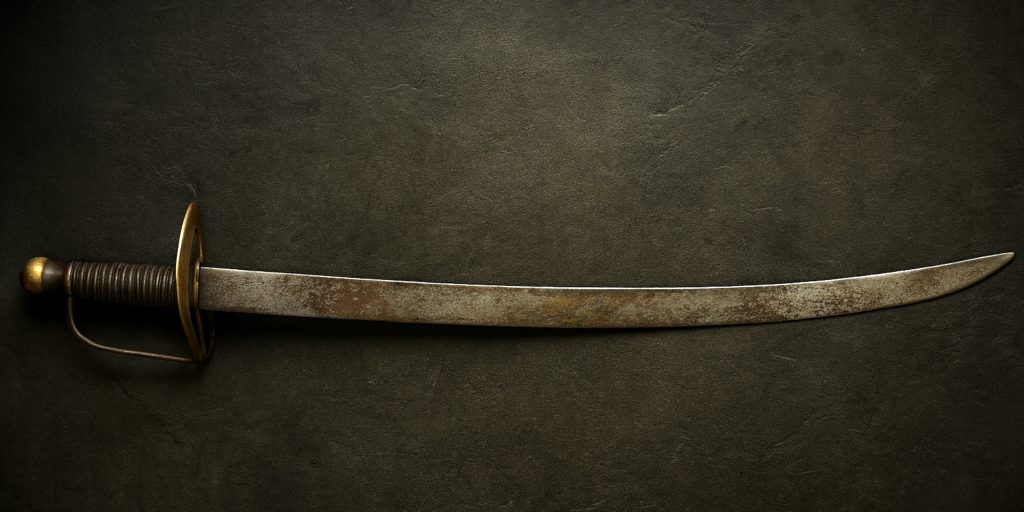
During the American Revolution, swords took on a highly symbolic value. Officers often carried spadroons, hangers, and sabres, some made by local craftsmen and others imported from France, Britain, or the Netherlands. Silver-hilted smallswords were still common, though less practical for combat.
The Continental Army adopted French patterns, including the short infantry briquet sabre, while the navy made use of cutlasses forged in American workshops. British forces carried light cavalry sabres, infantry spadroons, and naval cutlasses, while Hessian auxiliaries brought curved sabres of German origin.
American-made swords of the Revolution were often plain, with simple iron hilts, though some were decorated with patriotic motifs such as eagles or liberty caps. These blades were not standardised, but they reflected a growing ability to supply armies domestically. The sword was less decisive on the battlefield than the musket and bayonet, yet it remained the badge of command and a key weapon for cavalry charges and naval boarding actions.
Revolutionary War Era (1775–1783) (25 types)
- American-made cutlass
- American officer’s hanger
- American spadroon
- American sabre (locally forged)
- Silver-hilted American smallsword
- Smallsword with eagle pommel (Revolutionary)
- Hessian sabre (used by German auxiliaries)
- British infantry officer’s spadroon
- British light cavalry sabre
- British naval cutlass
- French infantry briquet sabre (ally imports)
- French naval cutlass
- Dutch hanger in Patriot militias
- American iron-hilt hanger
- Continental Navy cutlass
- Dragoon sabre (imported from France)
- American militia cutlass
- Smallsword with patriotic motifs
- Short sabre used by mounted officers
- Infantry hanger used by New England militias
- German hunting sword carried in colonies
- Eagle-hilted Revolutionary spadroon
- Naval hanger with shell guard
- Officer’s sabre engraved with motto
- American-made backsword
Early Republic and Nineteenth Century (1800 to 1860)

Following independence, the United States sought to standardise military equipment. The first official patterns included the Model 1799 dragoon sabre and the Model 1805 navy cutlass. These were influenced by French and British designs, with curved blades suited for mounted or naval combat.
By the 1830s and 1840s, the War Department introduced several distinctive models. The Model 1832 foot artillery sword, with its short, gladius-like blade, was based on ancient Roman forms. The Model 1840 cavalry sabre, nicknamed the “wristbreaker”, was a heavy curved blade inspired by French patterns. Staff, field, and militia officers carried elegant sabres with brass hilts and engraved blades.
This period also saw the rise of the American eagle pommel, a distinctly national style that adorned many militia swords. Fraternal organisations adopted ceremonial swords, blending military symbolism with ritual use. By the time of the Mexican-American War, the sword had become both a battlefield weapon and a powerful symbol of military prestige.
Early Republic and 19th Century (1800–1860) (45 types)
- US Model 1799 dragoon sabre
- US Model 1805 navy cutlass
- US Model 1812 officer’s spadroon
- US Model 1813 navy cutlass
- US Model 1832 foot artillery sword
- US Model 1833 dragoon sabre
- US Model 1834 navy cutlass
- US Model 1840 cavalry sabre (“wristbreaker”)
- US Model 1840 artillery sabre
- US Model 1841 navy cutlass
- US Model 1840 musician’s sword
- US Model 1840 officer’s sword
- US Model 1841 militia officer’s sword
- US Model 1841 cadet sword
- US Model 1840 light artillery sabre
- US Model 1840 heavy cavalry sabre
- US Model 1840 foot officer’s sword
- US Model 1840 staff and field officer’s sword
- US Model 1850 foot officer’s sword
- US Model 1850 staff and field officer’s sword
- US Model 1850 mounted officer’s sword
- US Model 1852 naval officer’s sword
- US Model 1859 staff officer’s sword
- American militia eagle pommel sabre (1820s–1840s)
- Militia NCO sword (1820s)
- Naval boarding sabre (early 19th century)
- American hunting sword
- Militia officer’s spadroon
- Presentation sabre (eagle pommel)
- US militia “five-ball” spadroon
- American fraternal ceremonial sword
- Civilian duelling smallsword
- US militia light artillery sabre
- US militia cavalry sabre
- Mexican War officer’s sabre (1846–48)
American Civil War Era (1861 to 1865)

The Civil War produced an extraordinary range of swords, reflecting both Union mass production and Confederate improvisation. Union officers and cavalry used the Model 1860 light cavalry sabre, lighter and more manageable than the earlier wristbreaker. Foot and staff officers carried slimmer swords, often of the Model 1860 pattern, while naval crews used the Model 1860 cutlass.
Confederate swords were often copies of Union designs but made with varying quality. Firms such as Boyle & Gamble or Leech & Rigdon produced officer’s sabres and cavalry swords, while others forged distinctive D-guard bowie swords, hybrids between sabres and large knives. Some Confederate blades came from Europe, particularly Solingen and British sabres of the 1821 pattern.
The sword in the Civil War was primarily a cavalry and officer’s weapon. Firearms dominated, but the sabre still saw use in close cavalry encounters and remained a visible mark of rank. Confederate examples often display local craftsmanship and scarcity of resources, making them highly prized by collectors today.
American Civil War Era (1861–1865) (35 types)
- US Model 1860 light cavalry sabre
- US Model 1860 staff and field officer’s sword
- US Model 1860 naval cutlass
- US Model 1860 foot officer’s sword
- Confederate cavalry sabre (generic pattern)
- Confederate officer’s sword (varied hilts)
- Confederate artillery sabre
- Confederate naval cutlass
- Confederate staff officer’s sword
- Leech & Rigdon cavalry sabre
- Dog River Confederate sabre
- Boyle & Gamble officer’s sword
- Confederate NCO sword
- Confederate D-guard bowie sword
- Kenansville cavalry sabre
- Confederate eagle-head officer’s sword
- Memphis Novelty Works sabre
- Cook & Brother officer’s sword
- US Naval Dahlgren cutlass (1861 pattern)
- Imported French sabres used by Confederates
- Imported British 1821 cavalry sabre (Confederates)
- Confederate artillery short sword
- Confederate naval boarding sword
- Confederate heavy cavalry sabre
- Confederate brass-hilt officer’s sword
- Confederate cavalry sabre by Louis Froelich
- US imported Prussian sabres (Union)
- US imported Solingen sabres (Union)
- Confederate foot officer’s spadroon
- Confederate “Palmetto” officer’s sword
- US Marine officer’s sword (Civil War era)
- Confederate “Atlanta Arsenal” sabre
- Confederate Texas cavalry sabre
- Confederate navy dirk-sword hybrid
- Union militia presentation sword
Late Nineteenth and Twentieth Century (1870 to 1945)

After the Civil War, the sword declined in practical use but grew in ceremonial importance. The Model 1870 naval cutlass was among the last functional boarding swords. The Model 1872 officer’s sabre introduced a lighter, more decorative style that set the pattern for later designs.
The turn of the century saw the Model 1902 officer’s sabre, still in use today for ceremonial purposes. The Model 1913 cavalry sabre, designed by George S. Patton, was a straight thrusting sword intended for modern cavalry tactics, but it saw limited use as horses gave way to mechanisation. Naval officers retained their own ornate swords, and the United States Marine Corps preserved the Mameluke sabre, first adopted in 1825 and still carried today.
Fraternal and ceremonial swords flourished in this period, carried by organisations such as the Knights Templar, Masons, and the Grand Army of the Republic. These ornate swords often featured etched blades, plated hilts, and symbolic motifs, reflecting the sword’s new role as a badge of honour rather than a weapon of war.
By the Second World War, the sword had vanished from combat, surviving only in dress and parade contexts. Yet its endurance in military tradition shows how the weapon remained a potent emblem of authority and heritage.
Late 19th and 20th Century (1870–1945) (40 types)
- US Model 1870 naval cutlass
- US Model 1872 cavalry officer’s sabre
- US Model 1872 staff officer’s sword
- US Model 1872 artillery officer’s sabre
- US Model 1875 cadet sword
- US Model 1880 cavalry officer’s sabre
- US Model 1880 staff and field sword
- US Model 1880 naval officer’s sword
- US Model 1890 infantry officer’s sword
- US Model 1892 cavalry sabre
- US Model 1902 officer’s sabre (still used ceremonially)
- US Model 1913 cavalry sabre (Patton sword)
- West Point cadet sword
- American fraternal ceremonial sword (Knights of Pythias)
- Masonic ceremonial sword
- Knights Templar ceremonial sword
- GAR (Grand Army of the Republic) ceremonial sword
- Spanish-American War naval cutlass
- Spanish-American War officer’s sabre
- Mexican-American border cavalry sabre (early 20th century)
- WW1 US cavalry sabre (1902 model in use)
- WW1 US Marine officer’s sword (1902 pattern)
- WW2 US Marine officer’s sword (Mameluke sabre)
- US Navy officer’s sword (1900s)
- Modern American ceremonial presentation sword

